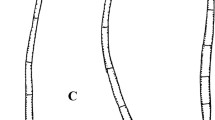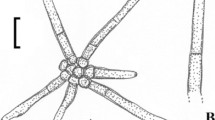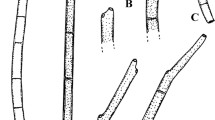Abstract
The common use of the name Capnodium citri to represent several species of sooty mold fungi is reviewed. Analysis of sooty mold specimens from Citrus in Florida found the species Antennariella californica and Chaetobolisia falcata with spherical fruitbodies and Caldariomyces fumago and Polychaeton citri with elongate fruitbodies. It is recommended that use of the name Capnodium citri for sooty mold on Citrus and ornamental plants is to be avoided because of its use for a number of species and on nomenclatural grounds.
Similar content being viewed by others
References
Berkeley MJ, Desmazières JBHJ. On some moulds referred by authors to Fumago, and on certain allied or analogous forms. J Hort Soc London 1849; 4: 244–260.
Reynolds DR. Capnodium salicinum Montagne emend. Mycotaxon 1978; 7: 501–506.
Fisher E. The sooty moulds of some Australian plants. Proc Roy Soc Victoria 1933; 45: 171–202.
Fraser L. An investigation of sooty moulds of New South Wales. I. Historical and introductory account. Proc Linn Soc NSW 1933; 58: 375–395.
McAlpine D. The sooty mould of citrus trees: a study in polymorphism. Proc. Linn. Soc. N.S.W. 1896. 21: 469–499.
Wescott C. Plant disease handbook. 3rd ed. New York: Van Nostrand Reinhold, 1971.
Wellman FL. Tropical American plant disease. Neotropical phytology problems. Metuchen, New Jersey: The Scarecrow Press, Inc., 1972.
Whiteside J, Garnsey S, Timmer L. Compendium of citrus diseases. St. Paul, Minnesota: APS Press, 1988.
Saccardo PA. Sylloge Fungorum. Pavatii,1822: Volume 1.
de Bary A. Comparative morphology and biology of the fungi, mycetozoa and bacteria. English translation by H.C.F. Garnsey, revised by J.B. Balfour. London: Frowde, 1887.
Persoon CH. Mycologia europea. Sectio prima. Erlangae: 1822.
Webber HJ. Sooty mold of the orange and its treatment. USDA Div Veg Physiol Pathol Bulletin 13. 1897.
Butler DJ. Fungi and disease in plants. Calcutta: Thacker, Spink, 1918.
Fawcet HS, Lee HA. Citrus diseases and their control. New York: McGraw-Hill, 1925.
Gaumann EA. Comparative morphology of fungi. English translation and revision by C.W. Dodge. New York: McGraw-Hill, 1928.
Stevenson JA. An account of fungi exsiccati containing material from the America. Nov Hed Weih 1971; 36: 1–563.
Pfister DH. A bibliographic account of exsiccatae containing fungi. Mycotaxon 1985; 23: 1–139.
Holgren PK. Holmgren NH, Barnett LC (eds). Index herbariorum. Part I: The herbaria of the world. 8th edition. Bronx, New York: New York Botanical Garden, 1990.
Farlow WG. On a disease of olive and orange trees occurring in California in the spring and summer of 1875. Bul Bussey Inst Bot Agr 1876; I: 404.
Underwood LM. Diseases of the orange in Florida. J Mycol 1891; 7: 27–36.
Seymour AB. Host Index of the Fungi of North America. Cambridge, Massachusetts: Harvard University Press, 1929.
Everitt JH, Escoba DE, Summy KR, Davis MR. Using airborne video, global positioning system, and geographical information-system technologies for detecting and map** citrus blackfly infestations. Southwestern Entomol. 1994: 19: 129–138.
Hubbard HG. Insects affecting the orange. Washington, D. C.: USDA Department of Agriculture, Division of Entomology, 1885.
Stevens FL. The fungi which cause plant disease. New York: Macmillan, 1913.
Heald FD, Wolf FA. A plant-disease survey in the vicinity of San Antonio, Texas. Washington, D.C.: USDA Bur Plant Ind Bul, 1912.
Anon. Index of Plant Diseases in the United States. Washington, D.C.: USA Handbook No 165, 1960.
Fawcet H S. Citrus diseases and their control. 2nd ed. New York.: McGraw-Hill, 1936.
Hepting GH. Diseases of forest and shade trees of the United States. Agriculture Handbook 386. Washington, D.C.: USDA Forest Service, 1971.
Batista AC, Ciferri R. The sooty-molds of the family Asbolisiaceae. Quaderno 1963. 31: 1–229.
Batista AC, Ciferri R. 1963a. Capnodiales. Saccardoa 2: 1298.
Dingley JM, Fullerton RA, McKenzie EHC. Survey of agricultural pests and diseases. Records of fungi, bacteria, algae and angiosperms pathogenic on plants in Cook Islands, Fiji, Kiribati, Niue, Tonga, Tuvalu, and Western Samoa. New Zealand DSIR Tech. Report 2. Rome: United Nations FAO, 1981.
Ellis JB, Everhart BM. The North American pyrenomycetes. Newfield, New Jersey: Private printing, 1892.
Sawada K. Descriptive catalog of Taiwan (Formosan) fungi. Part XI. Coll Agri Natl Taiwan Univ Spec Publ 1959; 8: 1–268, 12 pls.
Stevenson JA. The fungi of Puerto Rico and the American Virgin Islands. Contribution of Reed Herbarium No. XXIII, 1975.
Tulasne LR, Tulasne C. Selecta fungorum carpologia. (Translated into English by W.B. Grove). Volume 3, 1863.
Teodoro NG. Enumeration of Philippine fungi. Manila: Bur Pl Indust, 1937.
Viegas AP. Alguns fungos do Brasil. II. Bragantia 1944: 4: 1–392.
Yamamoto W. Formosan sooty mould fungi belonging to the Meliolaceae, Parodiellinaceae, Asterinaceae and Capnodiaceae. Mem Coll Agri Natl Taiwan Univ Spec Publ 1961: 10: 197–264.
Farr DF, Bills GF, Chamuris GP, Rossman AY. Fungi on plants and plant products in the United States. St. Paul, Minnesota: APS Press, 1989.
Ivbijaro MFN, Udensis UM, Ukwela Annonyako FV. Geographical distribution and host range in Nigeria of the mango mealy bug, Rastrococcus invadens Williams, a serious exotic pest of horticulture and other crops. Insect Sci Appl 1992;13: 411–416.
Parris GK. A revised host index of Mississippi plant diseases. Mississippi State University. Bot Dept Misc Publ 1959; 1: 1–146.
Sparks D, Yates IE. Pecan cultivar susceptibility to sooty mold related to leaf surface morphology. J Amer Soc Hort Sc. 1991; 116: 6–9.
Tedders WL, Smith JS. Shading effect on pecan by sooty mold growth. J Econ Entomol 1976; 69: 551–553.
Wood BW, Tedders WL, Reilly CC. Sooty mold fungus on pecan foliage suppresses light penetration and net photosynthesis. Hort Sci 1988; 23: 851–853.
Reynolds DR, Pohlad BR. Cyclic patterns of central Florida sooty molds. Proc Iowa Acad Sci.1974; 81: 12–13.
Pohlad BR. Cyclic patterns of central Florida sooty molds. MS thesis (unpublished). Orlando, Florida: Florida Tech. University, Orlando, Florida, 1975.
Miller VM, Bonar L. A study of the Perisporiaceae, Capnodiaceae, and some other sooty molds from California. Univ Calif Publ Bot 1941; 19: 405–428.
Kunze O. Revisio Generum Plantarum. Leipzig: A. Felix, 1891.
Woronochin NN. Zur Kenntnis der Morphologie u. Systematik der ruβtaupilze transkaukasiens. Annal Mycol 1926; 24: 231–264.
von Höhen F. Fragemente zur Mykologie III. No. 128. Wettsteinina n. g. Stizb Akad Wiss Wien 1907;116: 126–129.
Miller JH. Studies in the development of two Myriangium species and the systematic position of the Myriangiales. Mycologia 1938; 30: 158–181.
Luttrell ES. Taxonomy of the Pyrenomycetes. Univ Missouri Studies 25, 1951.
Luttrell ES. The ascostromatic ascomycetes. Mycologia 1955; 47: 511–532.
Luttrell ES. Loculoascomycetes. in: Ainsworth GC, Sparrow FK, Sussman AS, eds, The fungi, an advanced treatise. Vol. 4A. New York: Academic Press, 1973: 135–219.
Reynolds DR. Ascomycete systematics: The Luttrellian Concept. New York: Springer-Verlag. 1981.
Roquebert MF, Bury R. Leptoxyphium: Pycnide ou synnéma? Can J Bot 1988; 66: 2265–2272.
Reynolds DR. The capnodiaceous genus Scorias, reproduction. Natl Hist Museum LA Cty Contrib Sci 1978; 288: 1–16.
Kingma PH, van Beyna T. Untersuchungen über russtau. K. Akademie van wetenschappen, Amsterdam. Afdeeling naturk Verhand, tweede sect 1931; 39: 3–29.
Hughes SJ Sooty Moulds. Mycologia 1976; 68: 693–820.
Greuter W (ed). International Code of Botanical Nomenclature (Tokyo Code). Regnum Vegetabile Volume 131. Königstein, Germany: Koeltz Scientific Books, 1994.
Rose E. Contributionà l'étude de la fumagine, appelée aussi morfée maladie du noir. Bull Soc Bot France 1868. 14: 15–23.
Léveillé JH. Mycologie, Mycétologie: In d'Orbigny A, Dictionnaire univ d'Hist nat 1847, 8: 454–496.
Poiteau A, Turpin PJF Flore parisienne, contenant la description des plantes, que croissent naturellement aux environs de Paris. Ann Soc hortic de Paris 1833.
Sutton BC. The Coelomycetes, fungi imperfecti with pycnidia, acervuli and stromata. Kew, Surrey, England: Commonwealth Mycological Institute, 1980.
Author information
Authors and Affiliations
Rights and permissions
About this article
Cite this article
Reynolds, D.R. Capnodium citri: The sooty mold fungi comprising the taxon concept. Mycopathologia 148, 141–147 (1999). https://doi.org/10.1023/A:1007170504903
Issue Date:
DOI: https://doi.org/10.1023/A:1007170504903




